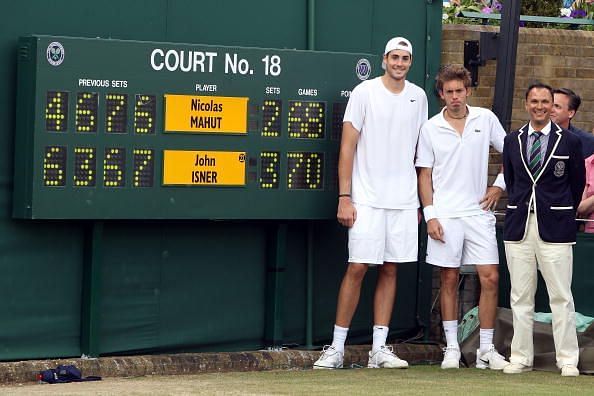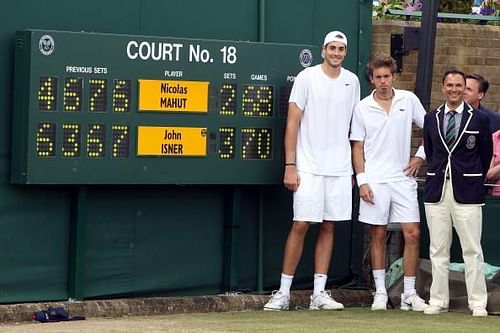
Australian Open and Wimbledon have adapted to easy-viewing experience, but how effective will that be?

Before the release of their fifth album, guitarist Mark Sheehan of the Irish band 'The Script' made their intentions clear. They had a fresh, new sound to deliver -- relevant to the modern times. "We have to be very reactive... it's either adapt, change, or die in this industry", he said.
And, that's one quote that is extremely relevant, no matter what field it is. You either adapt yourself to the changing times, or you become less and less relevant every day.
Sports, as a matter of fact, has always been in the midst of change, ever since it began. There hasn't been any sport that has stood the test of time without evolving and changing rules and regulations. Tennis itself, has gone through massive changes over the last half a century. So, why is there a sense of urgency in the most recent changes that have been inflicted on the sport?
ATP has been on their toes for a while now, about the necessity of reaching out to the younger generation of fans, as the men's field inches ever so closer to an era without any of the Big Four (or Five) giants. And, they have been somewhat successful in getting the younger tennis fans more interested in the stars, with their unrestrained publicity of the NextGen stars. While WTA hasn't quite been up to the mark yet on that front, they agreed with the ATP and the ITF to restrict the rankings up to 750 only, instead of the usual 2000+, to help more people make a living out of the sport.
But, the recent changes in the Grand Slams have certainly given the sport a new perspective, and more importantly, they are a definite stance on how tennis is going to be shaped in the near future.
Keeping the interest of viewers in mind, the Wimbledon Championships and the Australian Open have joined hands with the US Open to reduce the match lengths at the biggest stages. The previous rule used to have the decider as an advantage set (where the winner needs to have at least a 2-game difference once the score is 6-6) - 5th set for the men and 3rd for the women.
The US Open had done away with the rule back in 1970 itself, when they decided to have a tie-breaker if the deciding set came to 6-6. But, the growing concern over players' physical fitness, owing to the demanding nature of modern tennis, has finally led to the deadlock being broken at two of the other three majors.
Wimbledon recently announced that the deciding sets will have a tie-break after 12-12 in singles. That was possibly a direct culmination of the massive hue and cry that was raised following the epic six-and-a-half hour semi-final between John Isner and Kevin Anderson, where Anderson won the final set 26-24 in 2 hours and 50 minutes. Quite understandably, the still-fatigued 6'8" South African had nothing to offer on the day of the final against Novak Djokovic.
And now, with the first Grand Slam of 2019 just weeks away, the Australian Open announced a sudden change in their rules. The final set will be decided after a super tie-breaker at 6-6. Super tie-breakers are basically extended tie-breakers -- frequent in doubles' deciding sets -- where the first player to get to 10 points, with a minimum lead of 2 points, wins. And if it goes to 9-9, the first player to get a 2-point advantage, wins.
The changes have been made keeping in mind the current demands of the sport, and also to make the Grand Slams more watchable for the audience. The authorities firmly believe that the modern fans have short attention span and reducing match lengths will greatly help the sport in attracting a wider audience. In fact, Novak Djokovic himself isn't quite opposed to the idea and believes men's Grand Slam matches should be three-setters, since "Millennials don't have a great attention span".
Assuming that they lack the attention span for such matches, the change in rules does come off as a bit patronizing to the younger generation of fans, doesn't it? And, it's a very subjective realization as well, which can't be proven by any means. So, attending to the issue at hand in a more objective manner, what does this new change signify?
That it was made keeping in mind the men's spectrum of the sport, is a foregone conclusion. The women's matches, too, will have final set changes. But, in all honesty, they didn't require one, given their three-set lengths. What distinguished women's Grand Slam matches from the WTA Tour matches was the deciding advantage set rule. Notwithstanding, with that gone, it will possibly only diminish the importance of such matches, and Grand Slam matches (barring Roland Garros) won't test a player's mental and physical perseverance any more than the tour matches do.
The main change, understandably, will be on the men's side. The 70-68s or the 26-24s won't happen again. The extra mile that the players had to go previously, that extra effort they had to put in to try and hold another service game, to try and break the one on the other side of the net -- they won't have to go through that under the new rule. Neither will apparently lesser-known players have to battle it out for days to carve their names into the hall of fame.
What the authorities did is essentially killing off the advantage set as a possible temporary effect, since the talks of reducing men's matches to 3 sets or to 4-game sets haven't exactly gone down well with the players or the fans.
For that matter, in the last 5 years, only 16 men's matches at the Australian Open have gone past 12 games in the deciding set. Nine of those sixteen winners won their next round matches.
On the contrary, at Wimbledon, in the last 5 years, only six matches have gone past 12-12 in the decider. And, only twice have the winner made it past the next round. It does make a fair point about the obvious mental and physical fatigue that the men have to go through following a marathon.
But, marathon matches do still occur without going past 12 games in the decider. The 2012 Australian Open final between Novak Djokovic and Rafael Nadal, for example, was almost a six-hour classic without getting to the advantage-set stage. That could easily happen in any of the earlier rounds, too, potentially reducing the winner's chances of getting past the next round.
But, with the inclusion of tie-breakers, the potentially fatiguing mammoth contests will cease to exist. And, there is also the environment factor in Melbourne. The heat wave has troubled the players a fair bit in the recent editions, with mid-match retirements and walkovers reaching an unprecedented scale. At this point, five/six hour marathons is one of the last things they'd want to be involved in, despite having a high fitness level.
Although, whether the main problem has been tackled or not, remains to be seen. And, it directly concerns the biggest portion of the Grand Slam audience -- the casual viewers. With the four Grand Slams having four different deciding set rules, it'll be a massive confusion for the viewers about what to expect from each of the Slams.
Australian Open's super tie-breaker at 6-6 will surely garner more attention with its relatively new feel. Wimbledon, too, will have 12-12 as a defining stage for the tie-breaker to commence. The US Open has long been the tournament where new rules and regulations have been tried.
That leaves the French Open as the sole Grand Slam without a tie-breaker to decide the final set. And, with fans getting a taste of shortened matches, it may so happen that the clay Slam loses viewership due to the longer duration of its matches.
To add to that, as long as adapting to modern times goes, all the other three Grand Slams have adapted their regulations as and when needed, in the past. The exception, yet again is the French Open.
The reluctance to use Hawkeye on clay (which often leads to really controversial decisions that potentially affects the match, and the tournament), the reluctance to schedule night matches citing a change in character of the surface, or the unavailability of roofs to continue the main court matches during rain -- the tournament hasn't been a fan favourite in recent times.
The changes at the Australian Open and Wimbledon have been welcomed with open arms. And, it's still to be seen if the French Open will be flexible enough to join hands with the rest of the Majors, and there's still enough time to decide on that.
But, as long as they don't, the viewers will remain perplexed about the differing rules at the four Majors. Whether it'll be detrimental to the growing viewership of tennis, that's the crux of the matter. The authorities have gambled on a difficult situation, and, for the sake of the sport, it better pays off!